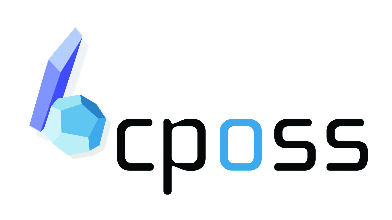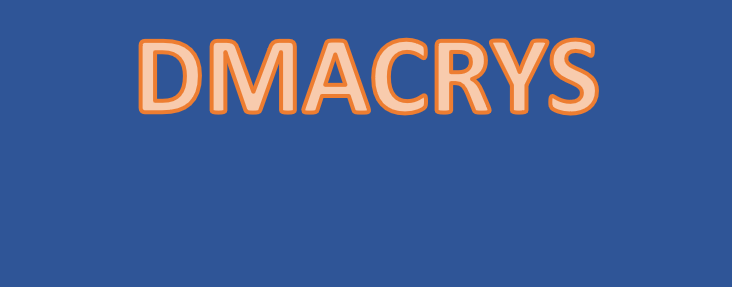




Symmetry analysis of k=0 phonon modes
Here are some instructions for the symmetry assignment of k=0 phonon modes
from DMAREL and NEIGHBOURS output.
I've used the structure am8 (fort.21 & prop.out)of
the uracil derivative Panos sent me. I made the RUDOLPh
input file for this = am8.rudolph
and an output file from RUDOLPh that contains the phonon eigenvectors in the
axis system needed for the symmetry analysis = am8.rudolph.f16.
> first step - matching representation numbers with symmetry labels
In fort.21 from neighbours, look for the sections near the top with 'LINEAR
BASIS FUNCTIONS', 'QUADRATIC BASIS FUNCTIONS' and 'ROTATION BASIS FUNCTIONS'
These tell you how the basis functions transform, i.e. to which representation
of the symmetry group they belong.
In the fort.21 for the am8 structure, you find the matrix:
LINEAR BASIS FUNCTIONS
X Y Z REP
0.00000 1.00000 0.00000 1
1.00000 0.00000 0.00000 2
0.00000 0.00000 1.00000 2
So X and Z belongs to representation 2, while Y belongs to rep 1.
Similarly, from the quadratic section, we have x^2,y^2,Z^2,xy in representation
4 and yz,xy in rep 3.
For the rotations, Ix and Iz are in rep3, while Iy is in rep4.
This crystal is P21/c, so these can be compared to the character table for
C2h, which says that:
xz,x^2,y^2,z^2 and Iy belong to Ag
yz,xy,Ix and Iz belong to Bg
y belongs to Au
x and z belong to Bu
(y and z are usually the other way around, but this is the order neighbours
has used - the key things is that there are 2 linear basis functions in Bu,
etc.)
So, our representation 1 is Au, rep 2 is Bu, rep 3 is Bg and rep 4 is Ag. Neighbours always orders them with the totally symmetric representation as the last representation.
----------
> second step - get basis functions for each symmetry
Further down in the fort.21, you have a listing of translational and rotational
basis functions. These are a basis for all molecular motions, so any normal
mode has to be a combination of these. They are listed by representation, so
we just need to match them up with the calculated phonon eigenvectors to label
the symmetry for the modes.
In the am8 example, go to where it says 'TRANSLATION FUNCTIONS' in the fort.21.
The key thing is the phase of each basis function. The first line says that,
in representation 1 the y translations of molecules are in phase (all positive,
++++). Similarly, z translations alternate positive (molecule 1), negative (mol
2), positive (mol 3), negative (mol4) = +-+-. Third line: x translations do
the same +-+-.
Similarly, in representation 2 are x translations ++++, y translations +-+-,
z translations ++++
Similarly, in representation 3 are x translations ++--, y translations +--+,
z translations ++--
Similarly, in representation 4 are x translations +--+, y translations ++--,
z translations +--+
Then, for the ROTATION FUNCTIONS
in representation 1, rotations go as +--+ for Ix, ++-- for Iy, +--+ for Iz
in representation 2, rotations go as ++-- for Ix, +--+ for Iy, ++-- for Iz
in representation 3, rotations go as ++++ for Ix, +-+- for Iy, ++++ for Iz
in representation 4, rotations go as +-+- for Ix, ++++ for Iy, +-+- for Iz
----------
> third step - compare phonon eigenvectors to basis functions
All of the basis functions in the previous step are for translations in the
GLOBAL axis frame (given in terms of the unit cell at the top of fort.21). Rotations
are around the molecular LOCAL axes and the phases might not match up with those
around the principal axes used in DMAREL. Right now, RUDOLPh transforms these
and writes the eigenvectors to fort.16 in the axis system we need.
I've included the RUDOLPh input file and resulting fort.16 (which I renamed
am8.rudolph.f16). I should change the output in DMAREL to write eigenvectors
in this axis system, to save a step in the process.
The first 3 vibrational modes are the acoustic ones (frequency = 0 at k=0),
so look at vibration 4 first. For am8, this is mainly translational. The x translation
has phase +-+-, which matches with what we found for representation 1 in the
previous step. As a check, the z-rotation has phase -++- (= +--+), which agrees
with what we should find in representation 1. So, vibrational mode 4 is Au.
Similarly, vibration 5 has x and z translational components both with phase
+--+, so this is representation 4 = Ag. Note the rotations could have been used
to make the same assignment: rotations about Y are ++++.
Going through all vibrational modes for am8:
vibs 5,7,10,18,19 and 23 are Ag
vibs 6,8,14,17,20 and 24 are Bg
vibs 4,11,12,16 and 22 are Au
vibs 9,13,15 and 21 are Bu
Of 24 modes, 6 are Ag, 6 are Bg, while only 5 Au and 4 Bu. This is because the
3 acoustic modes are in the symmetry of the X,Y and Z basis functions (step
1) - two in Bu and one Au.
© UCL Chemistry Department 2022. This page was last updated on 17 August, 2022. If you have any problems with this page please email the WebMaster